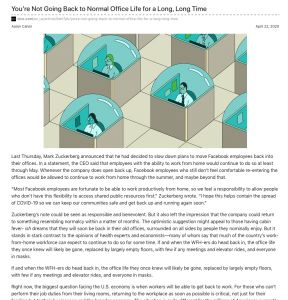Join getAbstract to access the summary!

Join getAbstract to access the summary!
Maxwell Strachan
You’re Not Going Back to Normal Office Life for a Long, Long Time
Vice News, 2020
What's inside?
Those now working from home may never return to the office.
Recommendation
Reporter Maxwell Strachan lays out the challenges facing businesses and their employees as the United States grapples with the novel coronavirus and a crippled economy. What will have to happen for workers to return to an office environment and work productively again face-to-face? What changes can you expect to be long-term – or even permanent? There will be a new normal, but not the normal you knew.
Take-Aways
- Most employees currently working from home (WFH) will be doing so longer than they expect or prefer.
- Governmental and institutional guidelines encourage companies to promote telework for employees whose physical presence is not essential.
- Even when stay-at-home restrictions are rescinded, businesses must change to accommodate the “new normal” of life with coronavirus.
- Businesses must embrace robust social distancing and hygiene measures to protect employees and to maintain their economic viability and corporate reputation.
Summary
Most employees currently working from home (WFH) will be doing so longer than they expect or prefer.
Facebook CEO Mark Zuckerberg told employees who work remotely that they should expect to stay home through May 2020. He suggested the company could return workers to their offices even later than that – perhaps not until the summer of 2020.
“Right now, the biggest question facing the US economy is when workers will be able to get back to work.”
However, such a course of action is unlikely and may be unwise. Health experts and economists believe Zuckerberg spoke prematurely. They are much less sanguine about the prospect of anything resembling normal office life returning any time soon. They emphasize that working from home should be a priority for quite a while. Employees will return to a new office dynamic, one of barely occupied spaces, quarantined elevators, mandatory masks and few face-to-face meetings.
Governmental and institutional guidelines encourage companies to promote telework for employees whose physical presence is not essential.
Guidelines from President Donald Trump’s administration recommend that employers “encourage telework.” Think tanks across the political spectrum, such as the Center for American Progress (liberal) and the American Enterprise Institute (conservative), concur with this recommendation.
“One recent University of Chicago study found that 37% of US jobs can ‘plausibly be performed entirely at home’ – a number that jumps to near 50% in metropolitan areas like San Francisco and Washington, DC.”
Distancing guidelines are intended to keep people from congregating as much as possible until a vaccine, some other highly effective prophylactic options or effective treatments are available. This is likely to take a minimum of a year and perhaps as long as two. The old normal is not coming back.
Even with the rescinding of stay-at-home restrictions, businesses must change to accommodate the “new normal” of life with coronavirus.
Governor Andrew Cuomo of New York asked employers to “reimagine” their workplaces to limit the possibility of future outbreaks. Ask, for example, what is the minimum number of people who absolutely need to be physically present in your office and what functions do they perform? Without widespread testing, robust contact tracing and identification of confirmed immunity, many employers will not bring workers back to shared workspaces.
“If and when WFH-ers do head back in, the office life they once knew will likely be gone, replaced by largely empty floors, with few if any meetings and elevator rides, and everyone in masks.”
People who can and do work from home tend to be better paid already; going forward, they’ll enjoy superior protection from contagion than their less well-paid colleagues who have to commute to the office. Some workers may feel pressure to return to workplaces that feature dangerous crowding and a lack of proper hygiene. Responsible businesses should reshape their work environments to accommodate social distancing until a vaccine is widely available.
Jonathan Dingel, an economics professor at the University of Chicago’s Booth School of Business, believes that companies must rethink their perspective on remote versus office employees. He says that usually remote workers are less productive, but argues that if they can do “a reasonably good job,” employers should not bring them back into an office.
Businesses must embrace robust social distancing and hygiene measures to protect employees and to maintain their economic viability and corporate reputation.
A Smithfield pork processing plan in South Dakota turned out to be a major COVID-19 outbreak site; hundreds of employees sickened. The facility shut down, and publicity surrounding the event caused significant damage to the company’s image. No business wants to be in the situation of facing financial disaster and possible legal liability.
Cheek to jowl attendees can no longer pack conference rooms. Open-plan offices jammed with cubicles are a thing of the past. Every office worker will need to wear a mask and have constant, easy access to hand sanitizer. Offices will need regular, frequent, deep cleaning. No more than two or three people should occupy an elevator at any time.
“Even if an employer does everything right, a COVID-19 outbreak at the office will remain a distinct possibility.”
Leaders must communicate their company’s policies clearly and be prepared to back them up with sanctions. Companies that don’t institute precautions should anticipate that their employees will leave for organizations that demonstrate more respect for their well-being even at the risk of less profit. Laggard firms may suffer productivity losses among their remaining employees who fear for their health.
Working from home may remain – or become again – an employee’s best option.
About the Author
Maxwell Strachan, a senior editor at Vice, was a senior reporter at HuffPost, covering media, culture and politics.
This document is restricted to personal use only.


















Comment on this summary